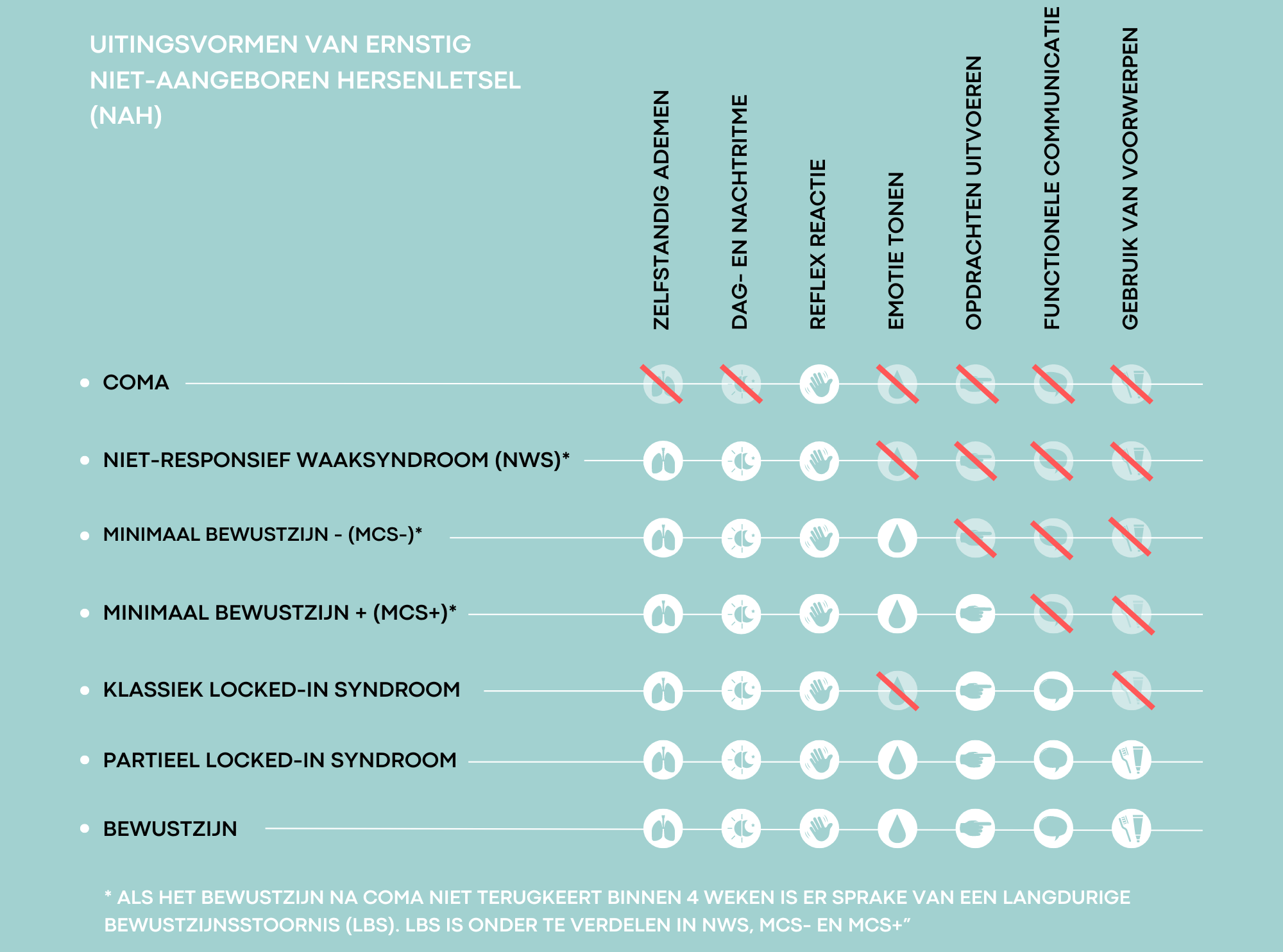Manifestations of serious acquired brain injury
Someone who suffers a serious brain injury almost immediately falls into a coma. Most people who survive the acute phase of the brain injury regain consciousness within a few days to weeks. But this does not apply to everyone. Most people go through a number of successive levels of consciousness before they are fully approachable again.
Below is a schematic overview of the different manifestations of severe acquired brain injury. These are explained in more detail below the image.

Coma
Coma is a state of complete unconsciousness. The patient's eyes remain closed and he/she reacts to strong stimuli with a few simple reflexes at most. In addition, basic bodily functions such as breathing and temperature regulation are often disrupted. The cause of a coma is a disruption of the wake-sleep center at the top of the brain stem. This can happen after an accident, brain hemorrhage or oxygen deficiency, for example.
Non-responsive waking syndrome (LBS)
An unresponsive waking syndrome (formerly called a vegetative state) is a condition in which the patient shows no signs of consciousness when performing commands. However, the patient does occasionally open the eyes and can breathe independently. There is often a disturbed day/night rhythm. The cause is probably a disruption of areas in the brain that are responsible for transmitting sensory information and for activating the rest of the brain.
The Minimal Conscious State (LBS)
The minimally conscious state (minimal conscious state; MCS) is a state in which consciousness is severely reduced, but in which people do show one or more signs of consciousness. Examples of reactions that can be seen in people in a minimally conscious state are:
- Performing a simple command
- Answering simple questions with yes or no or with gestures
- showing emotions or
- showing goal-oriented behavior such as following with the eyes or looking at with the eyes
MCS can be divided into minimum conscious state minus (MCS-) and minimum conscious state plus (MCS+). At minimal conscious state minus (MCS-), conscious reactions are present, but there is no behavior that indicates understanding language. People in the minimum conscious state plus (MCS+) do show behavior that indicates language comprehension. For example, they can carry out simple assignments, say words or show intentional communication with their environment. The latter means that there is communication, but that this communication is often not yet accurate.
Locked-in syndrome
Locked-in Syndrome (LIS) is a specific form of severe acquired brain injury that involves the preservation of consciousness. In most cases (86%), LIS is caused by an infarction or bleeding in the front part of the pons. The pons is a part of the brainstem and connects the cerebrum to the cerebellum. In almost 14% of cases, LIS is the result of traumatic brain injury, but it can also be incidental to bleeding in the brain.
People with LIS have severe chronic and physical disabilities. Three forms of LIS can be distinguished: classical, partial and total. In the classic form, one is completely paralyzed and can only communicate by means of vertical eye movements and/or blinking of the eyelids. With the partial form, more is possible, such as being able to move an arm. The total form involves complete paralysis, including the vertical eye movements and blinking of the eyelids, which makes communication impossible. The sensation is present because the nerve pathways responsible for this lie behind the punch injury and are spared. People with LIS are able to make decisions for themselves that have to do with care and treatment.
Consciousness (confused conscious)
Awareness is when a patient can communicate in one way or another and also understands what is being said. There is also consciousness when he/she can perform two different assignments. There are almost always the following problems:
- a prolonged period of confusion
- severe memory impairment
- Deviant behavior
- motor and/or sensory function disorders

